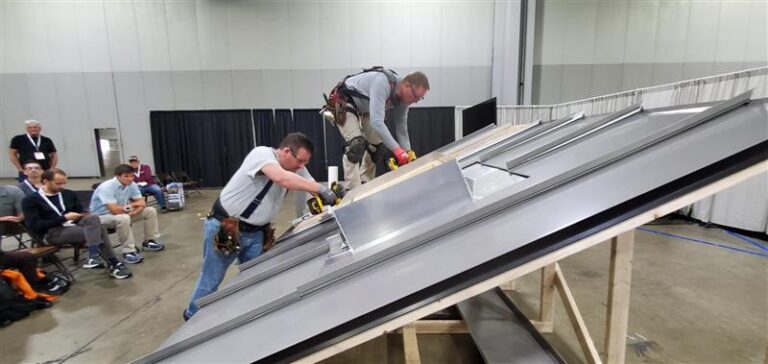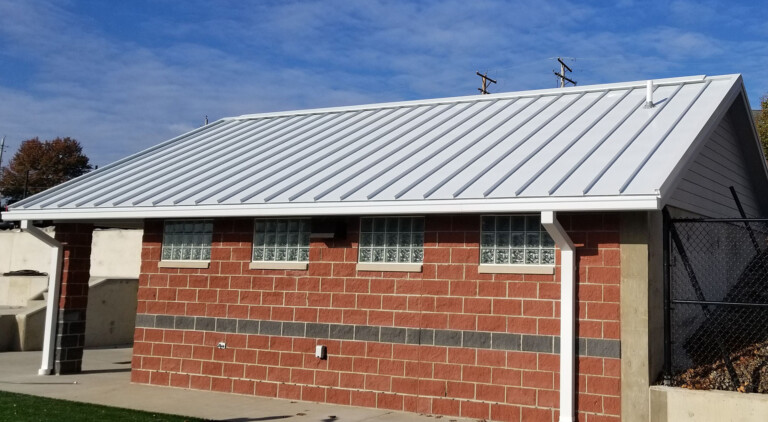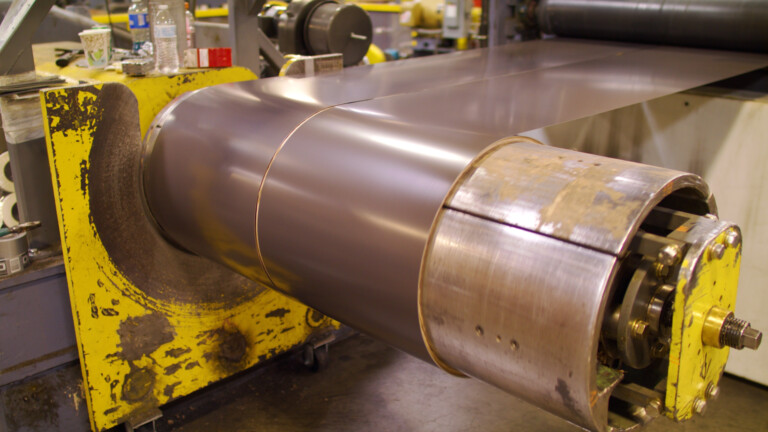What Is Steep-Slope Metal Roofing? Best Profiles for Steep Roofs
Knowing the pitch or slope of your roof is critical when determining which standing seam metal roofing profile to install. Discover the best profiles for steep-slope roofs before you buy.
In metal roofing, the slope of the structure is everything.
In one of our most recent articles, we discussed the best profiles for low-slope standing seam metal roof applications. However, if you don’t have a low-slope roof, you might be wondering what profiles will work for steep-slope roofs.
Like low-slope roofs, there are special considerations to know before you choose a profile for a steep-sloping roof.

One of our top priorities at Sheffield Metals is to make sure our customers are using the right system and profile based on the property’s specific attributes. That’s why we believe it’s important to share information about steep-slope roof systems and what profiles we recommend to accommodate your project.
In this article, expect to learn:
- What is considered steep-slope
- How to measure roof slope
- Why choosing the right profile matters
- Our profile recommendations for steep-slope roofs
What is Considered a Steep Slope?
The most common industry standard for what is considered steep slope is any roofing structure that is above a 3/12 pitch. Keep in mind that some manufacturers might use a different number as their definition of a steep slope, but above a 3/12 tends to be the most widely recognized. At Sheffield Metals, we also consider anything above a 3/12 as a steep sloping structure.
How to Measure the Slope or Pitch of a Roof

If you’re unsure of what the slope/pitch of a roof structure is, it’s relatively easy to calculate. To determine your roof pitch, you’ll need to measure how many inches your roof rises over every 12-inch run.
Using a ruler or tape measure, move inward on the flat roof plane (parallel to the ground) 12 inches. Once you reach 12 inches, mark it, and then measure how far the roof rises perpendicular to the ground. For example, if your roof rose 8 inches for every 12 inches, the roof pitch is 8/12.
Beyond physically measuring your roof slope, there are also apps available on your phone or tablet that will give you an approximate slope measurement. However, it’s recommended that you verify the slope that the app provides with an actual measurement of the structure as well.
If you can’t reach your roof or feel uncomfortable climbing a ladder, don’t hesitate to ask your roofing contractor to measure it for you.
Industry Testing of Steep-Slope Metal Roofing Systems
As you may or may not know, low-slope and steep-slope roofing systems have different industry-standard testing requirements. Steep-slope metal roofing systems are tested to meet ASTM E1646 standards, which determines the system’s resistance to water penetration under uniform positive static air pressure differences.
ASTM E1646 exists to simulate what rain would do to a steep-slope roof system and how well it can shed water in a similar weather event. During the test, there is a little bit of water back-up on the roof system, then static air pressure is applied to see if any of this water penetrates the roof. If any water leaks through, it constitutes a failure.
So, you know that if a profile passes the ASTM E1646 test, it’s a good indicator that it will work well for a steep-slope roofing application.
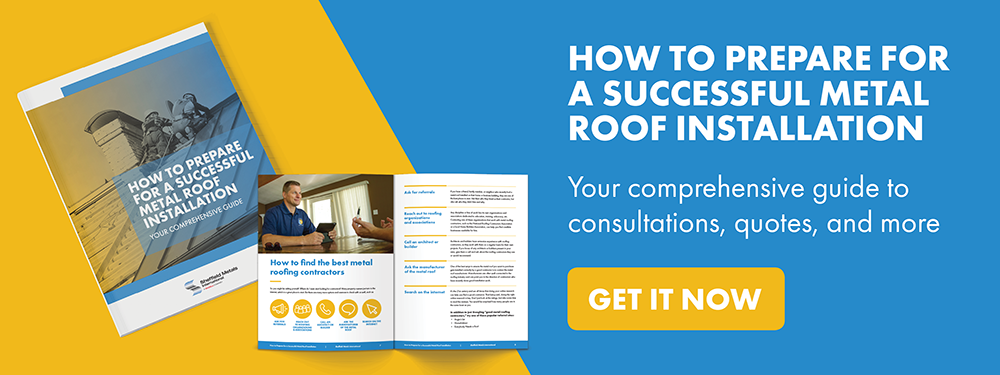
Best Profiles for Steep-Slope Metal Roof Applications
Unlike low-slope roof systems, steep-slope standing seam metal roofs have more options available to choose from, including both snap-lock and mechanically seamed profiles.
For reference:
- Snap-lock profiles are panels that have been carefully rollformed with a male and female leg that snap together and do not require hand or mechanical seaming during installation.
- Mechanically seamed profiles are rollformed with specific edges that line up with each other. Once the two panels are engaged, a hand or mechanical seamer is used to bend the edges and lock the panels together. Mechanically seamed profiles are either single-lock (one fold – 90-degree seam) or double-lock (two folds – 180-degree seam).
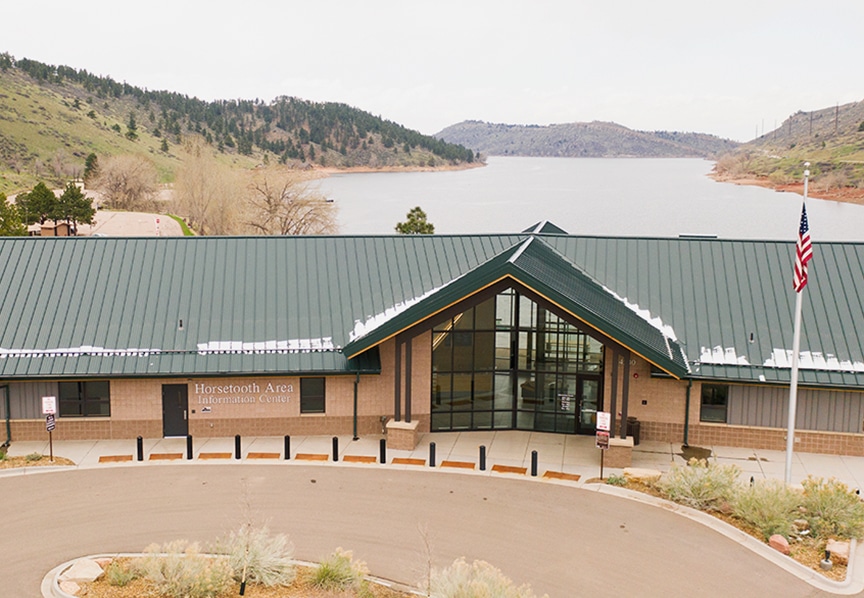
There are a couple of considerations to keep in mind when choosing between a snap-lock or mechanically seamed profile for your steep-slope project:
- We recommend that snap-lock metal roofing systems be used for anything ranging from a 3/12 pitch to about a 7/12 pitch. Luckily, a majority of roofing structures fall somewhere between a pitch of 4/12 and 9/12.
- Since there’s less of a concern for pooling/standing water with steep-slope roofs because it’s a hydrokinetic roof system, installing a mechanically seamed system might be an added unnecessary expense. Mechanically seamed profiles cost more because the installers have to align the panel legs and then seam them together, which is a more labor-intensive process than a simple snap-lock profile.
- With the addition labor of install, there is also the potential for more nicks, dents, and scratches to your system. Remember, steep-slope roofs are likely to be more visible from the ground than a low-slope roof. So just keep in mind that there could be some more noticeable aesthetic issues.
- Another consideration to remember is that snap-lock profiles are more susceptible to disengaging due to thermal movement of built-up snow/ice. So if your project is in a region where snow and temperature fluctuations occur, it might make more sense to go with a mechanically seamed profile. This will make it less likely to separate at the seam from thermal movement.
Let’s go through a few examples of steep-slope profile options.
#1: Sheffield Metals 1.5” SnapLock 550
- Panel Type: Standing seam
- Panel Seam: Snap-lock
- Panel Width: 19” (steel) | 15” (aluminum)
- Seam Height: 1.5”
- Panel Material: 22 to 24-gauge min steel | .032 to .040 aluminum
- Panel Surface: Smooth | Embossed optional
- Panel Clip: Required per engineering
- Minimum Slope: 2/12
- Substrate: Plywood (steel) | Plywood, b-deck, b-deck with ISO (aluminum)
#2: Sheffield Metals 1.75” SnapLock

- Panel Type: Standing seam
- Panel Seam: Snap-lock
- Panel Width: 18” (steel) | 16” (aluminum)
- Seam Height: 1.75”
- Panel Material: 22 to 24-gauge min steel | .040 aluminum
- Panel Surface: Smooth | Embossed optional
- Panel Clip: Required per engineering
- Minimum Slope: 2/12
- Substrate: Plywood, b-deck, b-deck w/ ISO
#3: Sheffield Metals 1.5” Mechanical Seam
- Panel Type: Standing seam
- Panel Seam: Mechanical
- Panel Width: 16”
- Seam Height: 1.5”
- Panel Material: 22 to 24-gauge min steel | .032 to .040 aluminum
- Panel Surface: Smooth | Embossed optional
- Panel Clip: Required per engineering
- Minimum Slope: 2/12 | 1/12 (steel only – based on project conditions and inseam sealant application)
- Substrate: Plywood, b-deck, b-deck w/ ISO
#4: Sheffield Metals 2.0” Mechanical Seam
- Panel Type: Standing seam
- Panel Seam: Mechanical
- Panel Width: 18” (steel) | 16” (aluminum)
- Seam Height: 2.0”
- Panel Material: 22 to 24-gauge min steel | .040 aluminum
- Panel Surface: Smooth | Embossed optional
- Panel Clip: Required per engineering
- Minimum Slope: .5/12 for steel (based on project conditions and inseam sealant application) | 2/12 for aluminum
- Substrate: Open framing, plywood, b-deck, b-deck w/ ISO
Final Thoughts on Steep-Slope Metal Roofing
As we mentioned, if you have a steep-slope roof, you have more profile options to choose from, including most variations of mechanically seamed or snap-lock profiles. To ensure you have the most protection for your home or building, also verify that the profile that works with your slope is an engineered standing seam metal roofing system.
Remember, if you need assistance in measuring your roof pitch/slope or picking the correct profile or system, ask your roofing contractor and they can help you.
Here at Sheffield Metals, we’ve assisted hundreds of contractors and property owners choose and install the best roofing profile based on the project’s slope and other critical design considerations. Best of all, we have engineering on numerous standing seam metal roof profiles that are a good fit for steep-slope roofs.
Contact one of our helpful metal roofing specialists today to discuss your roofing project!

